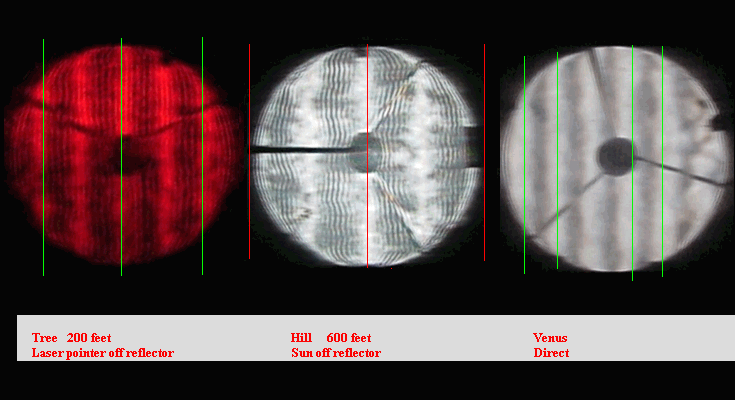

Here we see the same mirror being tested three different ways using a ronchi grating. Click on the image of each ronchi-gram to see the setup that was used. The distances need not be exact in fact they were not measured exactly. In the left ronchi-gram are the lines bulging slightly showing spherical aberration? Maybe, its hard to tell. In the 'Sun off reflector' and 'Venus Direct' there is certainly lots of turbulence which has been frozen in the photograph. All three ronchi-grams show about one wave length of turned edge. Since the grating is inside the focal length of the mirror center we see lines rather than all dark or all light as would be the case at the mirror focal point. The turned edge has a longer focal length than the rest of the mirror so the grating is further from the focal point of the edge. There are more and narrower lines at the mirror edge. What are the smaller lines and why are there none in the 'Venus Direct' ronchi-gram? The reason is that Venus has a larger diameter than the artificial stars causing the diffraction lines to be blurred. There is more about this effect later in the 'Build your own Telescope' program.
Well, you can see the mirror is not perfect. Not all the mottled appearance is due to turbulence. Some is due to surface roughness known as 'Dog Biscuit'. And the mirror edge besides being turned down is also somewhat wavy. The picture at right of Saturn was taken through this 12 1/2 inch telescope on a night when the seeing was not that great. In this picture you can see the Cassini division in the rings and a dark band and possibly a white cloud at the left limb below the band. The conclusion is that you can test your telescope without expensive equipment if you have the time and patience.
The automotive reflector I used is shown below. You can see the reflection of me and the sun. I used a high quality ronchi grating from Edmund Scientific mounted on the lid from a gallon can of paint thinner. The edges of the tin can lid were crimped in three places to slip over an eyepiece tube. If crimped just right the springiness of the lid will hold it onto the tube. If you have a high quality printer you can print your own ronchi gratings on transparency paper using the graphics supplied below. Use the graphic from Stellafane to adjust the printer magnification then you can print a whole page of ronchi grating using the other graphic. At one time we supplied gratings made from printable transparency with this program. We have a few remaining.